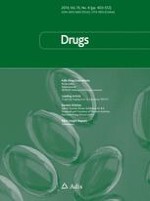Erschienen in:

01.11.2004 | Review Article
Prevention of Type 2 Diabetes Mellitus Through Inhibition of the Renin-Angiotensin System
verfasst von:
Prof. André J. Scheen
Erschienen in:
Drugs
|
Ausgabe 22/2004
Einloggen, um Zugang zu erhalten
Abstract
Type 2 diabetes mellitus is becoming a major health problem associated with excess morbidity and mortality. As the prevalence of type 2 diabetes is rapidly increasing, prevention of the disease should be considered as a key objective in the near future. Besides lifestyle changes, various pharmacological treatments have proven their efficacy in placebo-controlled clinical trials, including antidiabetic drugs such as metformin, acarbose and troglitazone, or antiobesity agents such as orlistat. Arterial hypertension, a clinical entity in which insulin resistance is common, is strongly associated with type 2 diabetes and may precede the disease by several years. While antihypertensive agents such as diuretics or β-adrenoceptor antagonists may worsen insulin resistance and impair glucose tolerance, newer antihypertensive agents exert neutral or even slightly positive metabolic effects. Numerous clinical trials have investigated the effects of ACE inhibitors or angiotensin II receptor antagonists (ARAs) on insulin sensitivity in hypertensive patients, with or without diabetes, with no consistent results. Almost half of the studies with ACE inhibitors in hypertensive nondiabetic individuals demonstrated a slight but significant increase in insulin sensitivity as assessed by insulin-stimulated glucose disposal during a euglycaemic hyperinsulinaemic clamp, while the other half failed to reveal any significant change. The effects of ARAs on insulin sensitivity are neutral in most studies.
Mechanisms of improvement of glucose tolerance and insulin sensitivity through the inhibition of the renin-angiotensin system (RAS) are complex. They may include improvement of blood flow and microcirculation in skeletal muscles and, thereby, enhancement of insulin and glucose delivery to the insulin-sensitive tissues, facilitating insulin signalling at the cellular level and improvement of insulin secretion by the β cells.
Six recent large-scale clinical studies reported a remarkably consistent reduction in the incidence of type 2 diabetes in hypertensive patients treated with either ACE inhibitors or ARAs for 3–6 years, compared with a thiazide diuretic, β-adrenoceptor antagonist, the calcium channel antagonist amlodipine or even placebo. The relative risk reduction averaged 14% (p = 0.034) in the CAPPP (Captopril Prevention Project) with captopril compared with a thiazide or β1-adrenoceptor antagonist, 34% (p < 0.001) in the HOPE (Heart Outcomes Prevention Evaluation) study with ramipril compared with placebo, 30% (p < 0.001) in the ALLHAT (Antihypertensive and Lipid-Lowering Treatment to Prevent Heart Attack Trial) with lisinopril compared with chlortalidone, 25% (p < 0.001) in the LIFE (Losartan Intervention For Endpoint reduction in hypertension study) with losartan compared with atenolol, and 25% (p = 0.09) in the SCOPE (Study on Cognition and Prognosis in the Elderly) with candesartan cilexetil compared with placebo, and 23% (p < 0.0001) in the VALUE (Valsartan Antihypertensive Long-term Use Evaluation) trial with valsartan compared with amlodipine. All these studies considered the development of diabetes as a secondary endpoint, except the HOPE trial where it was a post hoc analysis. These encouraging observations led to the initiation of two large, prospective, placebo-controlled randomised clinical trials whose primary outcome is the prevention of type 2 diabetes: the DREAM (Diabetes REduction Approaches with ramipril and rosiglitazone Medications) trial with the ACE inhibitor ramipril and the NAVIGATOR (Nateglinide And Valsartan in Impaired Glucose Tolerance Outcomes Research) trial with the ARA valsartan. Finally, ONTARGET (ONgoing Telmisartan Alone and in combination with Ramipril Global Endpoint Trial) will also investigate as a secondary endpoint whether it is possible to prevent the development of type 2 diabetes by blocking the RAS with either an ACE inhibitor or an ARA or a combination of both. Thus, the recent consistent observations of a 14–34% reduction of the development of diabetes in hypertensive patients receiving ACE inhibitors or ARAs are exciting. From a theoretical point of view, they emphasise that there are many aspects of the pathogenesis, prevention and treatment of type 2 diabetes that still need to be uncovered. From a practical point of view, they may offer a new strategy to reduce the ongoing epidemic and burden of type 2 diabetes.
